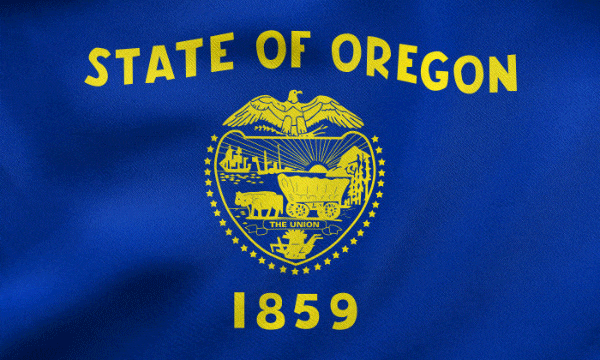

Capital: Salem
State abbreviation/Postal code: Ore./OR
U.S. Representatives: 5
Organized as territory: Aug. 14, 1848
Entered Union (rank): Feb. 14, 1859 (33)
Present constitution adopted: 1859
Motto: Alis volat Propriis (She flies with her own wings) (1987)
State symbols:
flower Oregon grape (1899)
tree douglas fir (1939)
animal beaver (1969)
bird western meadowlark (1927)
fish chinook salmon (1961)
rock thunderegg (1965)
colors navy blue and gold (1959)
song “Oregon, My Oregon†(1927)
insect swallowtail butterfly (1979)
dance square dance (1977)
nut hazelnut (1989)
gemstone sunstone (1987)
seashell Oregon hairy triton (1991)
beverage milk (1997)
mushroom Pacific golden chanterelle (1999)
Nickname: Beaver State
Origin of name: Unknown. However, it is generally accepted that the name, first used by Jonathan Carver in 1778, was taken from the writings of Maj. Robert Rogers, an English army officer.
10 largest cities (2010 est.): Portland, 583,776; Eugene, 156,185; Salem 154,637; Gresham, 105,594; Hillsboro, 91,611; Beaverton, 89,803; Bend, 76,639; Medford, 74,907; Springfield, 59,403; Corvallis, 54,462
Land area: 98,381 sq mi (254,806 km2)
Geographic center: In Crook Co., 25 mi. SSE of Prineville
Number of counties: 36
Largest county by population and area: Multnomah, 735,334 (2010); Harney, 10,135 sq mi.
State forests: 780,000 ac.
State parks: 231 (95,462 ac.)
Residents: Oregonian
2016 resident population est.: 4,093,465
Spanish and English sailors are believed to have sighted the Oregon coast in the 1500s and 1600s. Capt. James Cook, seeking the Northwest Passage, charted some of the coastline in 1778. In 1792, Capt. Robert Gray, in the Columbia, discovered the river named after his ship and claimed the area for the U.S.
In 1805 the Lewis and Clark expedition explored the area. John Jacob Astor's fur depot, Astoria, was founded in 1811. Disputes for control of Oregon between American settlers and the Hudson Bay Company were finally resolved in the 1846 Oregon Treaty, in which Great Britain gave up claims to the region.
In the agricultural sector, greenhouse and nursery products such as daffodils, gladioli, irises, lilies, peonies and tulips for bulbs are Oregon's most valuable. Hay is Oregon's second ranked crop generating 7% of the state's total agricultural receipts.
Ryegrass, wheat and onions are also valuable crops within the state. Oregon produces almost all of the country's seed for bentgrass, fescue, ryegrass, crimson clover, Kentucky and merion bluegrasses and orchardgrass. Oregon is a leader in the production of peppermint oil and Christmas trees.
With the low-cost electric power provided by dams, Oregon has developed steadily as a manufacturing state. Leading manufactured items are lumber and plywood, metalwork, machinery, aluminum, chemicals, paper, food packing, and electronic equipment. Following the high-tech component industry is the wood processing industry where manufactured products include plywood, veneer and particleboard. Oregon leads the states in lumber production.
Crater Lake National Park, Mount Hood, and Bonneville Dam on the Columbia are major tourist attractions. Other points of interest include the Oregon Dunes National Recreation Area, Oregon Caves National Monument, Cape Perpetua in Siuslaw National Forest, Columbia River Gorge between The Dalles and Troutdale, Hells Canyon, Newberry Volcanic National Monument, and John Day Fossil Beds National Monument.
In 2012's Gallup's ideological survey, Oregon was ranked the third bluest (most liberal) state behind Washington DC and Massachusetts. In another 2012 Gallup survey, Oregon placed near the bottom of the most religious states. Oregon placed fifth from the bottom, tying with Rhode Island and ahead of only four states, all located in New England. Meanwhile, state education officials reported that more than 20,000 students took at least one AP exam in 2012. That's a third of the graduating 2012 class and a 6.6 percent increase from 2011.

No comments:
Post a Comment